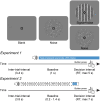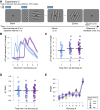Task-irrelevant stimuli reliably boost phasic pupil-linked arousal but do not affect decision formation
- PMID: 39551856
- PMCID: PMC11570621
- DOI: 10.1038/s41598-024-78791-8
Task-irrelevant stimuli reliably boost phasic pupil-linked arousal but do not affect decision formation
Abstract
The arousal systems of the brainstem, specifically the locus coeruleus-noradrenaline system, respond "phasically" during decisions. These central arousal transients are accompanied by dilations of the pupil. Mechanistic attempts to understand the impact of phasic arousal on cognition would benefit from temporally precise experimental manipulations. Here, we evaluated a non-invasive candidate approach to manipulate arousal in humans: presenting task-irrelevant auditory stimuli at different latencies during the execution of a challenging task. Task-irrelevant auditory stimuli drive responses of brainstem nuclei involved in the control of pupil size, but it is unknown whether such sound-evoked responses mimic the central arousal transients evoked during cognitive computations. A large body of evidence has implicated central arousal transients in reducing bias during challenging perceptual decisions. We thus used challenging visual decisions as a testbed, combining them with task-irrelevant sounds of varying onset latency or duration. Across three experiments, the sounds consistently elicited well-controlled pupil responses that superimposed onto task-evoked responses. While we replicated a negative correlation between task-evoked pupil responses and bias, the task-irrelevant sounds had no behavioral effect. This dissociation suggests that cognitive task engagement and task-irrelevant sounds may recruit distinct neural systems contributing to the control of pupil size.
© 2024. The Author(s).
Conflict of interest statement
Figures





Similar articles
-
Interplay between components of pupil-linked phasic arousal and its role in driving behavioral choice in Go/No-Go perceptual decision-making.Psychophysiology. 2020 Aug;57(8):e13565. doi: 10.1111/psyp.13565. Epub 2020 Mar 30. Psychophysiology. 2020. PMID: 32227366 Free PMC article.
-
Pupillometry and P3 index the locus coeruleus-noradrenergic arousal function in humans.Psychophysiology. 2011 Nov;48(11):1532-1543. doi: 10.1111/j.1469-8986.2011.01226.x. Epub 2011 Jul 18. Psychophysiology. 2011. PMID: 21762458
-
The accessory stimulus effect is mediated by phasic arousal: A pupillometry study.Psychophysiology. 2016 Jul;53(7):1108-13. doi: 10.1111/psyp.12653. Epub 2016 Apr 20. Psychophysiology. 2016. PMID: 27095087
-
Orienting and reorienting: the locus coeruleus mediates cognition through arousal.Neuron. 2012 Oct 4;76(1):130-41. doi: 10.1016/j.neuron.2012.09.011. Neuron. 2012. PMID: 23040811 Review.
-
Pupil Size as a Window on Neural Substrates of Cognition.Trends Cogn Sci. 2020 Jun;24(6):466-480. doi: 10.1016/j.tics.2020.03.005. Epub 2020 Apr 21. Trends Cogn Sci. 2020. PMID: 32331857 Free PMC article. Review.
Cited by
-
Salience-Dependent Disruption of Sustained Auditory Attention Can Be Inferred from Evoked Pupil Responses and Neural Tracking of Task-Irrelevant Sounds.J Neurosci. 2025 Apr 2;45(14):e2066232025. doi: 10.1523/JNEUROSCI.2066-23.2025. J Neurosci. 2025. PMID: 39904628
-
Catecholamines reduce choice history biases in perceptual decision making.PLoS Biol. 2025 Sep 3;23(9):e3003361. doi: 10.1371/journal.pbio.3003361. eCollection 2025 Sep. PLoS Biol. 2025. PMID: 40901785 Free PMC article.
References
-
- Aston-Jones, G. & Cohen, J. D. An integrative theory of locus coeruleus-norepinephrine function: adaptive gain and optimal performance. Annu. Rev. Neurosci.28, 403–450. 10.1146/annurev.neuro.28.061604.135709 (2005). - PubMed
-
- Bouret, S. & Sara, S. J. Network reset: a simplified overarching theory of locus coeruleus noradrenaline function. Trends Neurosci.28, 574–582. 10.1016/j.tins.2005.09.002 (2005). - PubMed
MeSH terms
Grants and funding
LinkOut - more resources
Full Text Sources

